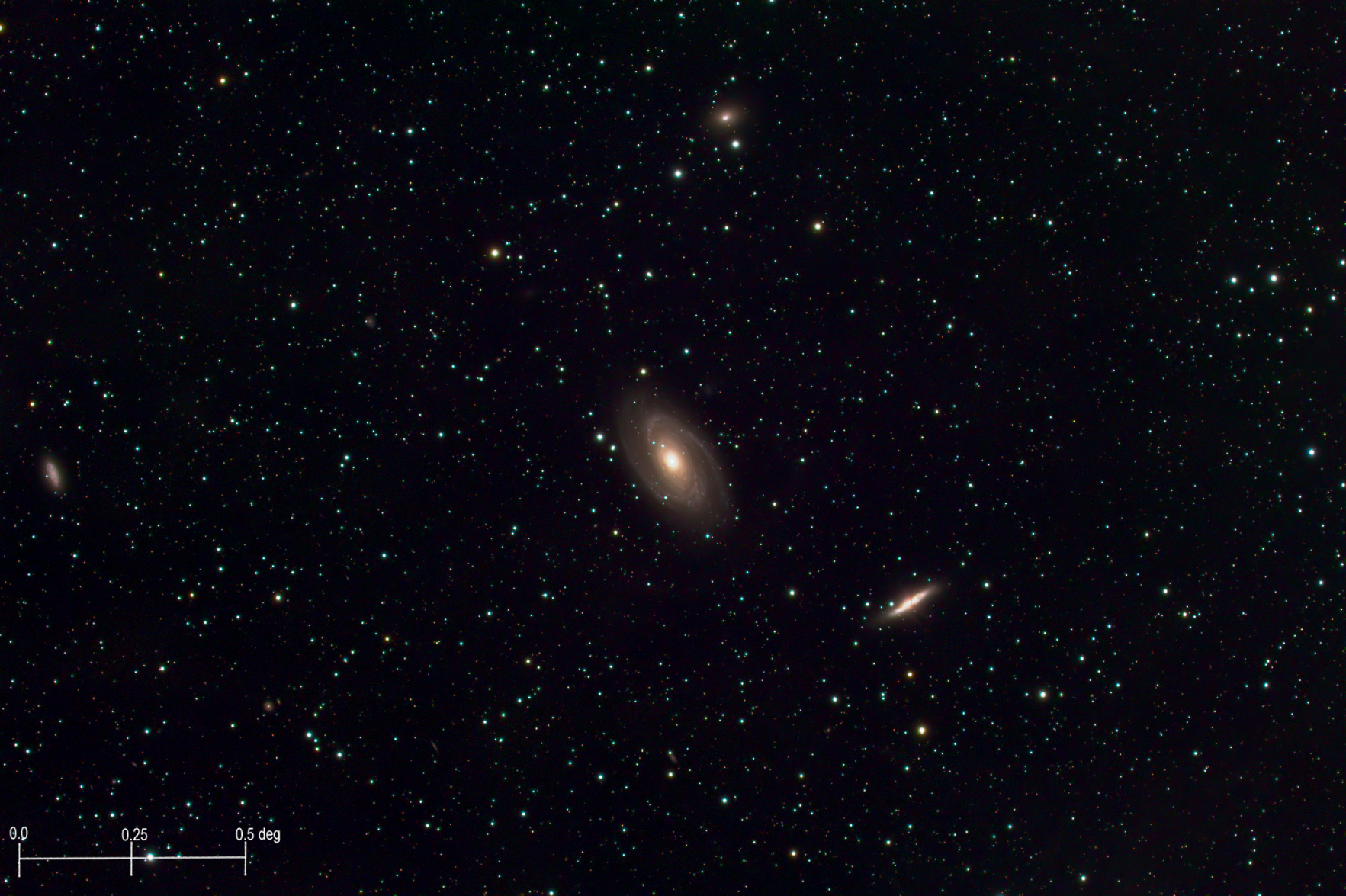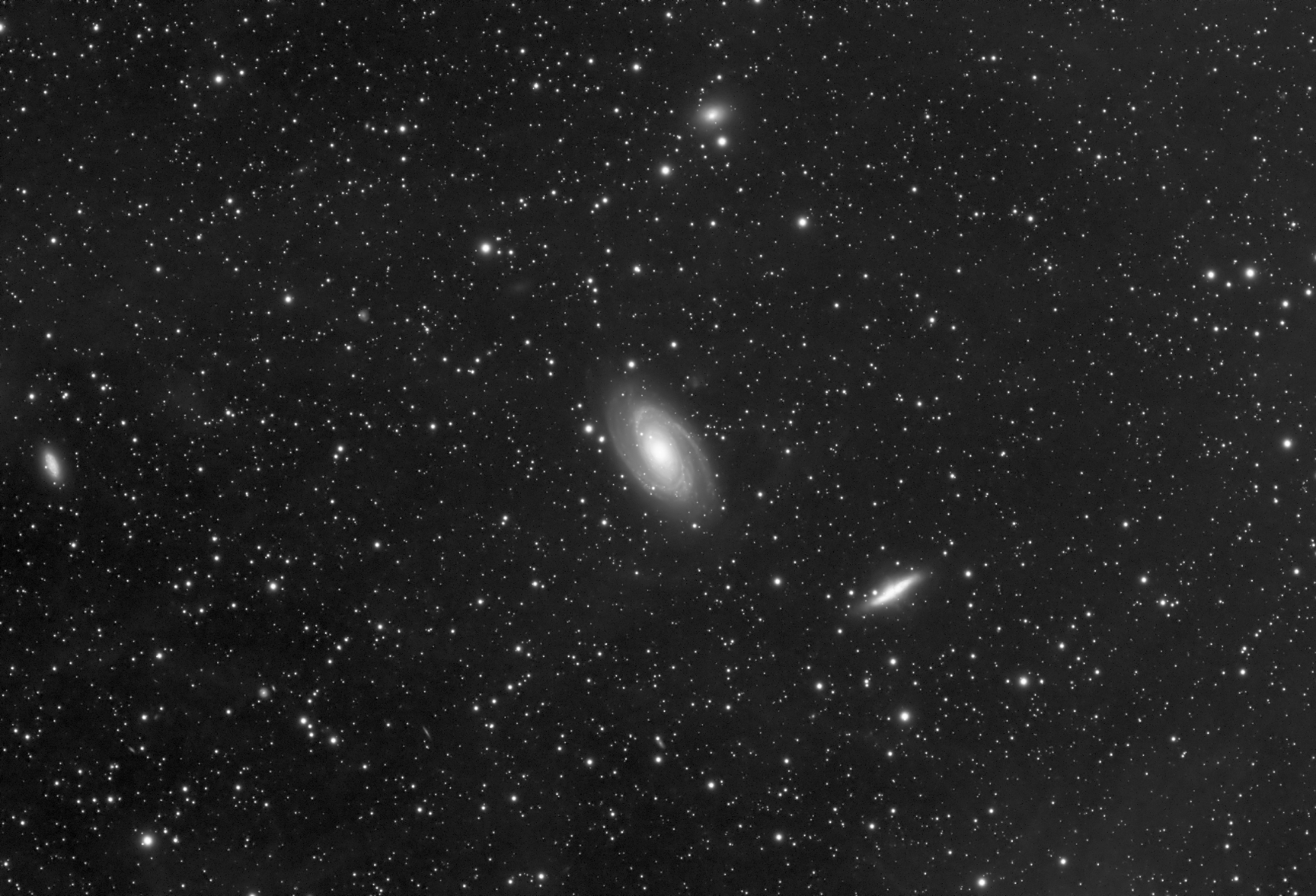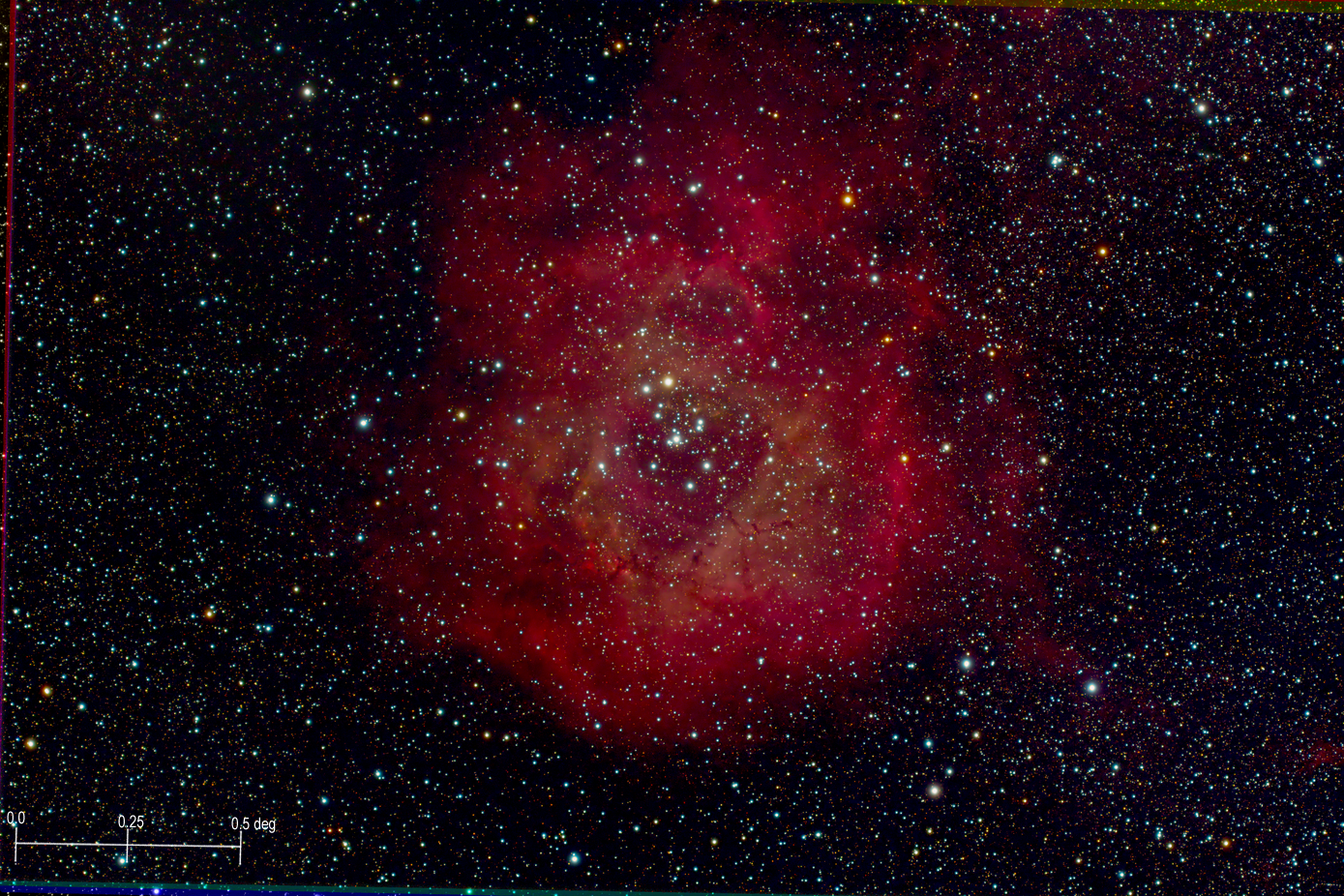𝐀𝐧𝐧𝐢𝐦𝐞 𝐖𝐨𝐧𝐠 on Nostr: Name: M81 Group - M81 (Bode's Galaxy) and M82 (the Cigar Galaxy) plus many others ...
Name: M81 Group - M81 (Bode's Galaxy) and M82 (the Cigar Galaxy) plus many others
Constellation: Ursa Major
It turns out there's always something new to discover...
The M81 Group is a cluster of around 30 galaxies close to, but not in, the Milky Way's sphere of influence, the Local Group. The primary galaxies (M81 and M82) were discovered by the German Astronomer Johann Bode in 1774. Bode is most famous today for his work on orbital mechanics and is the one who named the 7th planet Uranus (yes, it's his fault).
M81 epitomizes the grand design spiral galaxy, while M82 is what's known as a "starburst galaxy". It's still a spiral galaxy, but the gravity of M81 has "stirred up" dust withing M82, causing a huge spike in star formation. The result is that it's incredibly bright, so bright that the spiral arms of M82 can't easily be seen.
It also makes M82 prone to supernovae (the end life of a massive star; remember that lots of star formation means there are lots of O, B, and A type stars, which have short lifespans on the order of millions of years). In a 30-year period, we've detected at least 5 supernovae in that one galaxy. For reference, there hasn't been a supernova in our galaxy in almost 400 years.
Recently, it was discovered that both M81 and M82 are producing strange radio signals. M81's is a Fast Radio Burst (FRB). They're like sonar pings, except a single ping has the same energy output as a large star over several days.
M82's is even more bizarre. In 2010, a bright radio signal was suddenly detected and persisted for several years (it may still be ongoing). It doesn't match anything else we currently know, bu t currently little is written about it.
Now back to my image...
The camera I'm using is a special one. Perhaps it's most important feature is that it shoots natively in grayscale. Most digital cameras these days use what's called a Bayer filter (basically a pattern of pixels that can only see in either blue, red, or green) on the sensor. This makes it impossible for it to image truly in grayscale. A true grayscale sensor is desirable for two reasons. Firstly, Bayer filters have 2 green pixels for every red and blue pixel. Meanwhile, most things in the night sky are either red or blue, not green, meaning half the sensor isn't doing anything while it's imaging. Secondly, removing the filter makes it more sensitive per frame in general.
To get a color image from this, you need to use RGB filters that you then overlay onto each other. I've added two images this time, the first is the final RGB image, and the second is an overexposed frame without any filters (called a Luminescence frame).
When the exposure on this frame is boosted, you can start to see cloudy wisps. These are called IFN (Integrated Flux Nebula) and sometimes 'galactic cirrus'. It's not part of the M81 group; they're more like clouds above our own galaxy, illuminated by the starlight under it, making it a sort of reflection nebula. They're different from ISM (Interstellar Medium), but I think the difference is too subtle to go over here. Basically, it's all dust and dirt and gas in our galaxy
To date, there are no academic papers written on IFN, and the discovery of them seems to lie almost entirely with amateur astronomers. Exactly who discovered them is a bit of a debate, too. Some were first imaged by Palomar in the 1950s but weren't classified. Harry Rik seems to claim priority over the discovery of this class of object, based on unpublished papers written in the 1980s. Steve Mandel made major contributions in the mid-2000s, and Mel Bartels designed telescopes with the purpose of detecting these objects visually. To date, he's discovered over 100 different objects. Being able to see these visually is a feat that's hard to compare to anything, IFN are some of the faintest objects in the night sky.
In a time when "nothing ever happens" and "there's nothing new under the sun," I think it's exciting that new classes of objects within and around our own galaxy are still being discovered.


Constellation: Ursa Major
It turns out there's always something new to discover...
The M81 Group is a cluster of around 30 galaxies close to, but not in, the Milky Way's sphere of influence, the Local Group. The primary galaxies (M81 and M82) were discovered by the German Astronomer Johann Bode in 1774. Bode is most famous today for his work on orbital mechanics and is the one who named the 7th planet Uranus (yes, it's his fault).
M81 epitomizes the grand design spiral galaxy, while M82 is what's known as a "starburst galaxy". It's still a spiral galaxy, but the gravity of M81 has "stirred up" dust withing M82, causing a huge spike in star formation. The result is that it's incredibly bright, so bright that the spiral arms of M82 can't easily be seen.
It also makes M82 prone to supernovae (the end life of a massive star; remember that lots of star formation means there are lots of O, B, and A type stars, which have short lifespans on the order of millions of years). In a 30-year period, we've detected at least 5 supernovae in that one galaxy. For reference, there hasn't been a supernova in our galaxy in almost 400 years.
Recently, it was discovered that both M81 and M82 are producing strange radio signals. M81's is a Fast Radio Burst (FRB). They're like sonar pings, except a single ping has the same energy output as a large star over several days.
M82's is even more bizarre. In 2010, a bright radio signal was suddenly detected and persisted for several years (it may still be ongoing). It doesn't match anything else we currently know, bu t currently little is written about it.
Now back to my image...
The camera I'm using is a special one. Perhaps it's most important feature is that it shoots natively in grayscale. Most digital cameras these days use what's called a Bayer filter (basically a pattern of pixels that can only see in either blue, red, or green) on the sensor. This makes it impossible for it to image truly in grayscale. A true grayscale sensor is desirable for two reasons. Firstly, Bayer filters have 2 green pixels for every red and blue pixel. Meanwhile, most things in the night sky are either red or blue, not green, meaning half the sensor isn't doing anything while it's imaging. Secondly, removing the filter makes it more sensitive per frame in general.
To get a color image from this, you need to use RGB filters that you then overlay onto each other. I've added two images this time, the first is the final RGB image, and the second is an overexposed frame without any filters (called a Luminescence frame).
When the exposure on this frame is boosted, you can start to see cloudy wisps. These are called IFN (Integrated Flux Nebula) and sometimes 'galactic cirrus'. It's not part of the M81 group; they're more like clouds above our own galaxy, illuminated by the starlight under it, making it a sort of reflection nebula. They're different from ISM (Interstellar Medium), but I think the difference is too subtle to go over here. Basically, it's all dust and dirt and gas in our galaxy
To date, there are no academic papers written on IFN, and the discovery of them seems to lie almost entirely with amateur astronomers. Exactly who discovered them is a bit of a debate, too. Some were first imaged by Palomar in the 1950s but weren't classified. Harry Rik seems to claim priority over the discovery of this class of object, based on unpublished papers written in the 1980s. Steve Mandel made major contributions in the mid-2000s, and Mel Bartels designed telescopes with the purpose of detecting these objects visually. To date, he's discovered over 100 different objects. Being able to see these visually is a feat that's hard to compare to anything, IFN are some of the faintest objects in the night sky.
In a time when "nothing ever happens" and "there's nothing new under the sun," I think it's exciting that new classes of objects within and around our own galaxy are still being discovered.
quoting note1lsm…ut89Name: NGC 2244, NGC 2237 - The Rosette Nebula
Constellation: Monoceros
If you ever want to gauge the uselessness of government, just cast your gaze toward the Rosette Nebula.
Why? The Rosette Nebula was made the state astronomical object of Oklahoma in 2019. Why this object specifically? Likely, because the state flower is a rose. I believe it is also the only state with "state astronomical object". Passed that, the object has no associated with Oklahoma.
The star cluster in the middle was discovered by English astronomer John Flamsteed in 1690, about eighty years after the telescope was invented. A little over one hundred years later, the nebula itself was discovered by English astronomer... John Herschel! Finally, something not discovered by either Messier or William Herschel! Granted, it was his son, but still! (Incidentally, despite having the last name Herschel, none of the Herschel family was Jewish as far as I could tell. Their family was so firmly entrenched in astronomy that their Coat of arms was literally an observatory.)
Anyway.
Supposedly, making the Rosette the "State Object" was done to "promote stargazing tourism" to Oklahoma, especially in the panhandle. But the nearby state of New Mexico has just as dark skies that are also much clearer and less turbulent. It's not to say people don't go to Oklahoma for this reason, but I doubt the average guy would learn about the "state object" and then say to his spouse "Babe! We just gotta go to Oklahoma!"
It's disheartening that instead of advocating for additional dark sky sites within the state, or reducing light pollution within cities, efforts seem to be focused on highlighting the few areas only marginally affected by light pollution for tourism purposes. Maybe light pollution isn't going to end the world, but in some ways it's just as dramatic. While global warming enthusiasts squabble over a .001C temperature increases in the North Atlantic Ocean, you can compare your view of the night sky from your back yard to a camp site a hundred miles away. The contrast can't be denied, you can literally see the problem.
There's something sad that part of the natural world is hidden from us when we live near a city, and that instead of taking even the smallest baby steps to fix it, we promote the last few areas that are only partially impacted by it for tourism. We're commodifing it. But then again, could you convince the average person that there is a problem, or that it's worth fixing?
I can already see the guy, grumpy that a "bunch'a snowflakes" want him to turn off his porch light at night, and so he installs a 6000mw blue LED spotlight in his front yard.
Well, I guess I'll get off my soap box now.
Honestly, there's not really much to say about about the Rosette that I didn't say about the previous object. It's a large emission nebula, a big star forming region, etc, etc, etc... But it is a much more pretty object than the Heart Nebula, in my opinion. Also, Monoceros is probably the bougiest way to say "Unicorn".
Oh, and like I said with Thor's Helmet, the names of these nebula is very unofficial. The Rosette is also sometimes called the Skull Nebula. Can you see why?
I realized that in a lot of astronomy photos, it's hard to get a sense of scale for what you're looking at. To help with that, I'll probably start trying to add a little scale marker of .5 degrees, which is about the same as the apparent size of the sun and the moon. I also left some artifacts in from my processing method, showing somewhat how it was taken.
I guess the only thing left to say is that this is probably the first picture I've taken of a DSO (short for Deep Space Object) that I'm actually kind of proud of. I'm eager to take more with this new method, but it seems it's going to be cloudy for the next week, and with the full moon out now, I'm not going to get the chance.
note1f00…c4la



